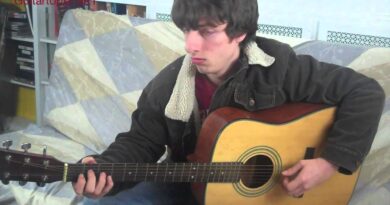Does string gauge effect guitar tone? Or is it a myth? Part 2
A while back Scott from Stringjoy strings hosted a guest video for us (https://www.youtube.com/watch?v=wAwhFkWLG5g ). Many comments wished for sound/playing examples, so here ya go!
In this video I’ll demo guitar strings from .008’s to .011’s (sorry, no 12’s or 13’s!)
Please subscribe, like and comment below with which gauge you preferred.
Also, if you’d like to support this channel, please consider checking out official Wampler merch (shirts, cups, jackets, and much more) at https://modyourownpedal.com/collections/all
#string #gauge #effect #guitar #tone #myth #Part
Originally posted by UCdVrg4Wl3vjIxonABn6RfWw at https://www.youtube.com/watch?v=1voGSrwut3U




I play a 7-string in A standard. I have a thick low string and it is definatley noticable. Its the difference between really good balanced tone and the low end dominating everything. Depending on your play style and the music you like, you might like that. Its a bit of preference.
I think I can hear a marked difference in playing between the gauges.
09:
The 9’s are lighter more jazz style with softer noodling and finger picking string snapping expressions.
Also there is more sliding and gliding between frets.
The tone is warmer, softer and more mellow with more ringing out.
With overdrive it’s a bit like Status Quo whatever you want.
10:
The 10s play as a harder more aggressive style and tone.There is less of the soft noodling and sliding around. It’s more of a working man’s stomp.There is still plenty of playing out and string snapping but the runs are more defined and deliberate and a bit more narrowly focussed, the 9’s had more flare and playing around the edges of the solo / melody line. I would definitely give the 9’s a try before moving on to the 10’s.
The 10s also edge towards more acoustic guitar / country style playing whereas the 9’s were solidly in the electric lead guitar camp.
11s
You could say that with the lower ‘drag’ the 8 & 9’s would be better suited for practicing, working on finger-drills and runs and so on and experimenting with new lines and improvisations and the 10’s are for playing a well rehearsed set live with attitude and still have plenty of elbow room to improvise and rock out.
The 11’s are for heavy rock out sets where you smash the guitar at the end
My choices = Electric is 10/52 drop – Acoustic is a work in progress. Great 3 yr old video plays the difference of tones! My experience it really just takes time in using different strings/gauges/tones/guitars to ultimately craft your gift! Play what gauge/guitar/sound makes you jump for Jesus when you play it out loud in a room all by yourself! Then keeping reaching!
Wow! This is just what I needed without actually buying each pack. I now have a really good idea of what sound I want thanks to this video. 9 or 10s seem to be spot on with what Im looking for. Thanks for your hard work in putting this video together. ????????????????????
Excellent video and great performance Brian!!!I think you sounded really great using the 11-48…killer beefy tones man!!!????????????????
Hello bro 10to 52 all the way
The longer the time between sound samples the harder it is to compare them. Also, listening to electric guitars in isolation is not very realistic or useful. All those tiny tonal nuances that don't matter to begin with become properly moot when playing in a mix.
You might have to re-EQ for lighter strings on some guitars and you definitely have to get use playing lighter on light strigs or they'll sound "wire-ey" as you said because you're over-playing them. Nuance is more attainable and more audible when the strings are lighter and more nuance makes you a better musician. Going right to .008s will probably take some time to get used to and then you'll wonder why you didn't make the change sooner.
I have found that thinner strings emphasize the mids and upper-mids to a greater extent and that the lower-mids are somewhat attenuated. That's where I want my guitar to be, so I use the thinnest strings I feel comfortable with, .008s – etc. and sometimes .009s – etc. On flattop and archtop acoustics I use .011s – etc. Martin Monels and my guitars thank me by sounding so much better.
This and other similar vids show that what I have always heard is right. The thinner the string, the better. You want more lower-mids and/or more volume? Well, that's what your amp's knobs are for.
You were biased and played the 8s with a lighter touch. Do a real A B test. 8s can cut through mix better.
I'm glad to see/hear you do this through a Tele. There is another very popular video like this where the guys tap about Stevie Ray's fat tone on his Strat while holding a Strat for effect and then they proceed to test out different gauge strings on a Les Paul. Mega fail on their part. With this video here you can definitely tell that the 8 and 9 gauge strings sound great for that more twangy country or surf style guitar but for more Jazzy or Fat Blues or Rock style, the thicker gauge strings do sounds better. So IMO you should mix and match to get the feel and tone that sounds and feels best to you.
If string gauge didn't affect guitar tone, then bass guitar wouldn't exist. Also, all guitar strings would be the same just tuned differently. The moon would be made of old croutons and the world's physical currency would be only nickels. Everything would cost the same amount, but you would only have the option of paying in nickels. It would be a similar reality, but with obvious differences. Most people wouldn't carry "cash," first of all. The people that didn't have credit cards would carry heavy bags of nickels. You could imagine more people would be wearing cargo pants.
I like Ernie Ball 9's super slinky, with the yellow dunlop tortex picks. My usual guitar is some kind of Ibanez RG with a floyd rose, so I think that's a pretty normal string choice for those guitars. For metallish stuff. For me the yellow dunlop tortex picks were a surprising favorite (started out with the green tortex as a favorite). Yellow is 0.73 mm, thick enough to be stiff, but with some give, and does good pick slides. I think the main thing is to deliberately and systematically experiment with strings and picks and find out what you like rather than decide what you like. Ignore what other people tell you they like. What they like is irrelevant to what you like, and you're allowed to like things other people don't like.
… 04/01/2020: Duhhh, put 8's on a Bass Guitar …. LOL
Speaking of strings, my teacher told me his trick when changing strings. Tune up a half step on all strings, play for a few minutes to make sure everything is seated and stretched, then tune normally. That extra tension really helps get things normalized. Also, I found a tool called a String Stretcha (actual name) It is a plastic stick about 8 inches long with a hook and heel on one end. You hook the string and rock it back and forth and run it up and down the length of the string from bridge to nut. Tune up to pitch, use the Stretcha, and then check it. You will see all the strings are damn near a whole step lower in pitch. And after that, you will have NO tuning issues. Rock solid. Here's the link
https://www.amazon.com/Stretcha-Str-7953/dp/B0085545YO
To me it's the tesion that really sets them apart, here the lighter strings sound warm and twangy, heavy ones are bright and loud
I basically have to play either 11-50 or 12-52. Gauges 10 and lighter break on my first step and half or double whole bends. Forty-five years on 11-50 and I'm not breaking strings. I bend allot with heavy vibrato.
I speak for all of us with rusty ole strings: it's not that we can't afford new strings, we're just too lazy to change 'em cause it's hard work.
Also James Jamerson never changed strings on his bass unless they snapped. Don't dare argue with James Jamerson. BTW people think James Jamerson played flatwounds – that is not true, they just turned to flatwounds due to his persistent no-stringchange policy.
This is of no help to me. If you want to do a serious comparison, record the same short passage on each gauge, CLEAN, and splice them together. Once through for neck, bridge and together. I don't want to hear distorted tone, or background music while you change strings and tune up.
I have stuck with tens on my Les Paul for over a year now. The tone is definitely nice, but there are downsides. First is having to put the guitar down sooner due to my finger tips getting munted. Second is some of the licks I used to play are too hard on 10s. I can't quite do every lick I try for. I am thinking of going back to nines. Playability is more important to me than tone. Angus had a pretty good tone using 9s too, so why make things hard for myself just because the internet says light strings are meh etc. Maybe they worry the internet will think they have small hands.
I love how the 8s sounded on the guitar. Very chimey. I play 9s as I am a newish player and it's easy to bend, etc., but I might drop to 8's for easier expression, and to see if I like the sound more in person.
Interesting.. It's all very subjective with sound, and I'd have thought it would also depend on what style/type of music you're playing, plus the guitars scale length and type. I'd also venture a guess that not everyone has hands like shovels either.. There are our more petite handed players that might struggle with heavier gauge strings. Personally I found a good compromise with D'Addario 9.5 to 44's on a Telecaster. If you want a thicker sound, (as I do), try adjusting your amps 'middle' tone control and ease back on the treble & bass. Use 'just enough drive' to get sustain.. Heavy Rock players, just turn it all up to 11 and it wont matter what guitar, amp, pedals and string gauge you use. ????